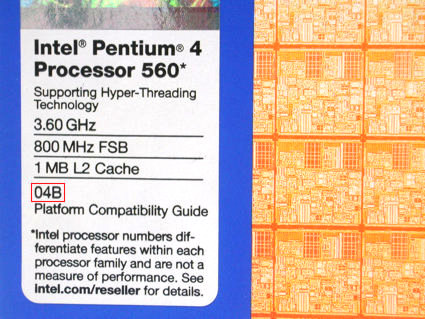The Mother of All CPU Charts 2005/2006
The 600 Series, Continued
If a prospective buyer wants to know what features his CPU of choice actually supports, he can determine this by looking at the last 5 numbers of the product code, which can be found on every CPU box. For example, the identifier SL836 indicates a 90nm part with HT technology, 04B platform compatibility, and 64-bit support.
You can find the product code here.
This denotes the compatibility with the 04A or 04B platform (these have different power requirements).
The SL-SPEC number on the CPU's heat spreader is also visible through the box's little plastic widow.
Despite its larger 2 MB L2 cache, the 600 series doesn't feature much of a gain in performance. The problem here lies with the larger cache's higher latencies. As a result, the average performance boost of the 600 series CPUs over the equivalent model of the 500 series roughly corresponds to about a 200 MHz clock speed difference. Mainly, this applies to applications that actually benefit from a larger cache, such as games.
For a long time after the introduction of the Pentium 4 660, things were very quiet. A full seven months passed before Intel followed up with the 3.8 GHz Pentium 4 670 in September 2005.
Get Tom's Hardware's best news and in-depth reviews, straight to your inbox.
Current page: The 600 Series, Continued
Prev Page Processor Updates Next Page Two Cores Sharing A Home: The Dual Core 800 SeriesTom's Hardware is the leading destination for hardcore computer enthusiasts. We cover everything from processors to 3D printers, single-board computers, SSDs and high-end gaming rigs, empowering readers to make the most of the tech they love, keep up on the latest developments and buy the right gear. Our staff has more than 100 years of combined experience covering news, solving tech problems and reviewing components and systems.



